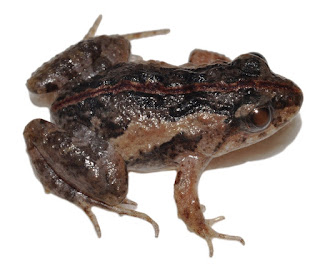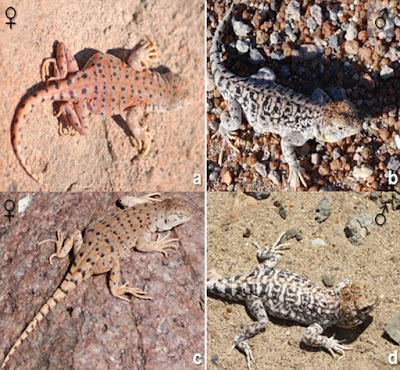[Most Recent Entries] [Calendar View]
Thursday, June 21st, 2018
| Time | Event | ||
| 2:02a | [Herpetology • 2018] Pseudopaludicola florencei • A New Species of Pseudopaludicola Miranda-Ribeiro (Anura: Leptodactylidae) from eastern Brazil, with Novel Data on the Advertisement Call of Pseudopaludicola falcipes (Hensel)
Abstract The Neotropical genus Pseudopaludicola includes 21 species, which occur throughout South America. Recent studies suggested that the population of Andaraí, in the state of Bahia, is an undescribed species, related to P. pocoto. Herein we formally describe this new species from lowlands of eastern Brazil. Recognition of this new species is supported by adult morphology, advertisement call, karyotype, and molecular data. It is diagnosed mainly by its small size, terminal phalanges knobbed (lack any expansion of the digital tips), proportionally short hindlimbs, 11 pairs of chromosomes, and advertisement call composed of series of three-pulsed notes, emitted at a high rate. In addition, we report for the first time the presence of P. pocoto in the campo rupestre (rupestrian grasslands) of Chapada Diamantina, a population with a much darker dorsal coloration than the population from the type locality. We also redescribed the advertisement call of P. falcipes based on recordings from topotypic males. Keywords: Amphibia, Advertisement call, bioacoustics, integrative taxonomy, Pseudopaludicola pocoto, morphologically cryptic species Pseudopaludicola florencei sp. nov. Pseudopaludicola sp. (Andaraí/BA): Duarte et al. 2010; Andrade et al. 2016 Pseudopaludicola sp. 1 (Andaraí/BA): Veiga-Menoncello et al. 2014 .... Etymology. The specific name honors Antoine Hercule Romuald Florence. Better known as Hercule Florence, a French artist, painter, polygrapher, and inventor, is acknowledged as the inventor of photography in Brazil in the 19th century. After his return from the Langsdorff’s expedition (from 1826 to 1829), Florence developed a system able to properly describe animal sounds, transcribing them into a five line music staff (Florence 1831, 1876; Toledo & Araújo 2017). Such method, termed as “Zoophonie” by Florence, was the first universal method of describing animal sounds and he is therefore designated as the “father of bioacoustics” (Vielliard 1993; Toledo & Araújo 2017). At least these two techniques (photography and zoophony = bioacoustics) are fundamental for species description nowadays (Köhler et al. 2017). Specifically, bioacoustics has proved to be efficient in clarifying the taxonomy of the genus Pseudopaludicola (as in the present study). Felipe Silva de Andrade, IIsabelle Aquemi Haga, Mariana Lúcio Lyra, Felipe Sá Fortes Leite, Axel Kwet, Célio Fernando Baptista Haddad, Luis Felipe Toledo and Ariovaldo Antonio Giaretta. 2018. A New Species of Pseudopaludicola Miranda-Ribeiro (Anura: Leptodactylidae: Leiuperinae) from eastern Brazil, with Novel Data on the Advertisement Call of Pseudopaludicola falcipes (Hensel). Zootaxa. 4433(1); 71-100. DOI: 10.11646/zootaxa.4433.1.4 BBC News Brasil - Os sapos menores que uma moeda e típicos do Brasil - e que ainda estão sendo descobertos bbc.com/portuguese/geral-44386319 Os microssapinhos menores que uma moeda e típicos do Brasil - e que ainda estão sendo descobertos g1.globo.com/natureza/noticia/os-micross | ||
| 7:47a | [Herpetology • 2018] Liolaemus audituvelatus • Molecular Evidence for Conspecificity of Two Desert Liolaemus Lizards (Iguania: Liolaemidae) Abstract Liolaemus audituvelatus (Núñez & Yáñez 1983) and L. manueli (Núñez, Navarro, Garín, Pincheira-Donoso & Meriggio 2003) are endemic species of the Atacama Desert of northern Chile that belong to the montanus group. Both species are considered cryptic from each other and can only be distinguished by their distribution ranges and karyotypes. Originally, there was a wide separation zone between their known distribution ranges, but later collections reduced the gap from 430 km to only 150 km. In this study, we review the geographic information about both species and report new localities within the distribution gap, where species identification becomes difficult. We performed a molecular phylogenetic analysis and applied several species delimitation methods to reassess the taxonomic status of both nominal species and new intermediate populations. Our analyses support the placement of L. manueli in the synonymy of L. audituvelatus. We discuss the biogeographic and conservation implications of this new synonymy. Key words: Atacama Desert, synonymy, species delimitation, Liolaemus audituvelatus, L. manueli, Phrynosaura Introduction Margarita R. De Gamboa, Claudio Correa, Yery Marambio-Alfaro, Edvin Riveros-Riffo and Juan C. Ortiz. 2018. Molecular Evidence for Conspecificity of Two Desert Liolaemus Lizards (Iguania: Liolaemidae). Zootaxa. 4438(2); 283–298. DOI: 10.11646/zootaxa.4438.2.4 |
| << Previous Day |
2018/06/21 [Calendar] |
Next Day >> |






